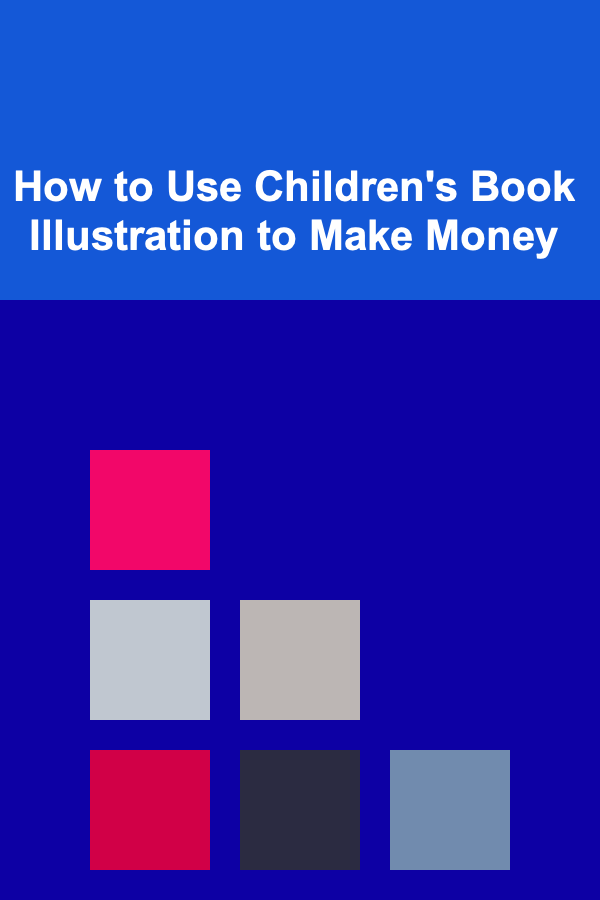
How to Use Children's Book Illustration to Make Money
ebook include PDF & Audio bundle (Micro Guide)
$12.99$7.99
Limited Time Offer! Order within the next:

Illustrating children's books is an exciting and rewarding career for those who are passionate about both art and storytelling. With a strong demand for new children's books in a growing global market, talented illustrators can not only contribute to the world of children's literature but also turn their creative skills into a profitable venture. In this article, we will explore various ways to use children's book illustration to make money, from traditional publishing to self-publishing, freelancing, and digital platforms.
Understanding the Role of Children's Book Illustrators
Children's book illustration goes beyond merely adding pictures to a story; it serves as an essential tool for engaging young readers, enhancing the narrative, and helping to convey emotions and themes. Illustrators must understand their target audience and the needs of both parents and children when creating these artworks. The visual elements of a children's book are often what attract young readers and encourage them to connect with the characters, settings, and storylines.
In order to successfully use children's book illustration to make money, an illustrator must possess a strong artistic skill set, creativity, and an understanding of the children's book market. Whether you are working with publishers, self-publishing your own books, or using digital platforms, there are numerous avenues for earning money from your illustrations.
Traditional Publishing Routes
One of the most common ways for illustrators to make money in the children's book industry is through traditional publishing. This involves working with established publishers to create illustrations for books that will be printed and distributed to bookstores, schools, and libraries worldwide.
Finding a Publisher
To break into the traditional publishing world, you need to find a publisher willing to work with you. The first step in this process is creating a portfolio showcasing your best work. A portfolio should highlight your style and versatility, with a focus on your ability to bring children's stories to life.
Publishers are typically on the lookout for illustrators whose work complements the tone and target age group of their books. You can find publishers who are open to submissions by attending industry events, researching publishers online, or using platforms such as SCBWI (Society of Children's Book Writers and Illustrators) to connect with potential clients.
Working with Literary Agents
Another avenue for securing work with traditional publishers is by working with a literary agent who specializes in children's literature. Literary agents can help you find publishers who are interested in your style and can negotiate contracts on your behalf. Agents often have relationships with publishers and are well-versed in the intricacies of the publishing world, which can make it easier for you to secure a project.
However, keep in mind that literary agents typically take a commission (usually 15-20%) from any work they secure for you. Therefore, while hiring an agent can increase your chances of landing high-profile projects, you should carefully consider whether it is the right choice for you.
Royalties and Advances
When working with traditional publishers, illustrators are typically compensated through a combination of advances and royalties. An advance is an upfront payment you receive for your work, which is usually paid in installments (e.g., upon signing the contract, completing sketches, and finishing the final illustrations). The royalty, on the other hand, is a percentage of the book's sales revenue.
While advances can vary significantly depending on the publisher and the scope of the project, royalties are typically between 5-10% of the book's retail price. It is important to note that you will not receive royalties until the book has sold enough copies to cover the advance you were paid. This means that if the book sells well, you can earn significant income through royalties, but you will need to be patient and strategic.
Self-Publishing Children's Books
The rise of digital technology has allowed many illustrators to bypass traditional publishing routes and self-publish their children's books. Self-publishing offers more creative control, higher royalties, and a faster time to market, but it also comes with added responsibilities such as marketing, distribution, and managing the production process.
Writing and Illustrating Your Own Books
If you have a story to tell, self-publishing can be an excellent option for creating and selling your own illustrated children's books. In this case, you would not only be responsible for the illustrations but also for writing the text, designing the layout, and making decisions about the book's overall look and feel.
The key to success in self-publishing is having a compelling story and an eye-catching visual style that appeals to children and parents. You also need to have strong knowledge of the self-publishing process, which includes formatting the book, preparing it for print or digital distribution, and managing the business side of things, such as copyright, taxes, and royalties.
Distribution Platforms
Once your children's book is completed, you will need to distribute it to your audience. Several online platforms make it easy to self-publish and distribute your book worldwide. Some of the most popular options include:
- Amazon Kindle Direct Publishing (KDP): Amazon's KDP platform allows you to publish both digital and paperback versions of your book and sell them on Amazon's marketplace. KDP offers high royalties (up to 70% on e-books) and a straightforward publishing process.
- IngramSpark: IngramSpark is a platform that allows you to print and distribute physical books to retailers, libraries, and schools worldwide. It is an excellent option for illustrators who want to have their books sold in traditional bookstores.
- Lulu: Lulu is another self-publishing platform that offers print-on-demand services and global distribution. It also offers various customization options for your book's format and cover design.
Self-publishing can be a profitable venture if you can effectively market your book and find a niche audience. Successful self-published illustrators often leverage social media, book bloggers, and online book clubs to build buzz around their work.
Marketing Your Self-Published Book
Marketing is crucial to the success of your self-published children's book. Here are a few ways to promote your book:
- Social Media: Use platforms like Instagram, Pinterest, and Facebook to share sneak peeks of your illustrations and engage with your audience. Create shareable content and build relationships with readers, parents, and educators.
- Book Launches: Organize virtual or in-person book launches to promote your new book. Partner with influencers, bloggers, and schools to help spread the word.
- Book Fairs and Conventions: Attend book fairs and conventions where you can showcase your book, connect with readers, and network with other authors and illustrators.
Freelancing and Commission Work
Freelancing offers another lucrative option for children's book illustrators to make money. Many authors, publishers, and educational companies hire freelance illustrators to create artwork for their projects, whether it's for a full children's book or for a single illustration used in a magazine, website, or educational resource.
Finding Freelance Work
There are several platforms where freelance illustrators can find work, including:
- Upwork: Upwork is a freelance marketplace where clients post job listings for illustrators, including those specializing in children's books. Freelancers can create profiles and bid on projects that align with their skills and interests.
- Fiverr: Fiverr allows freelancers to offer their services to clients looking for specific tasks, such as creating illustrations for children's books. Freelancers set their own rates and can work on smaller, quick-turnaround projects.
- Behance: Behance is a platform where illustrators can showcase their portfolios and connect with potential clients. Many publishers and authors browse Behance for freelance talent.
Working with Clients
When working as a freelance illustrator, it's important to establish clear communication and expectations with your clients. Discuss the scope of the project, deadlines, and compensation before starting work. Freelancers can be compensated on a per-project basis or an hourly rate, depending on the arrangement.
Licensing and Royalties
In some cases, freelance illustrators can earn money from licensing their illustrations for use in merchandise, educational materials, or digital products. Licensing agreements allow you to retain ownership of your artwork while granting others the right to use it for a specific purpose. This can be a long-term income stream if your illustrations are licensed for use in multiple products or projects.
Digital Platforms and Online Marketplaces
In addition to traditional publishing and self-publishing, illustrators can use digital platforms and online marketplaces to sell their artwork and make money. These platforms allow you to reach a wider audience and sell your work in various formats, from prints to digital downloads.
Selling Prints of Illustrations
If you have a distinct illustration style, selling prints of your artwork can be a profitable option. Websites like Etsy , Redbubble , and Society6 allow you to upload your artwork and sell prints, posters, and other merchandise like t-shirts, mugs, and phone cases. These platforms handle production, shipping, and customer service, allowing you to focus on creating new artwork.
Creating Digital Illustrations
Digital illustration is becoming increasingly popular, and many children's book illustrators are now creating artwork specifically for digital platforms. Illustrations can be sold as downloadable products or used in digital publications, apps, and e-books.
Creating Online Courses or Tutorials
If you have a wealth of knowledge about children's book illustration, you can monetize your expertise by creating online courses or tutorials. Platforms like Skillshare , Udemy , and Teachable allow you to create educational content that teaches aspiring illustrators how to improve their skills and break into the industry.
Conclusion
Using children's book illustration to make money involves a combination of artistic talent, business acumen, and strategic marketing. Whether you're working with traditional publishers, self-publishing your books, freelancing, or leveraging digital platforms, there are numerous ways to turn your passion for illustrating children's books into a profitable venture.
By understanding the intricacies of the children's book industry, developing a strong portfolio, and exploring multiple income streams, you can carve out a successful career as a children's book illustrator. With patience, persistence, and a bit of creativity, your artwork can resonate with young readers around the world and provide you with a steady income stream.
Reading More From Our Other Websites
- [Home Storage Solution 101] How to Conquer Paper Clutter: A Beginner's Guide to Filing and Document Storage for a Stress-Free Home
- [Personal Care Tips 101] How to Choose Between Different Types of Hair Oils
- [Personal Finance Management 101] How to Save Money on Home Maintenance Costs
- [Home Lighting 101] How to Create Ambiance with Lighting in Your Bedroom
- [Ziplining Tip 101] DIY Maintenance Tips to Extend the Lifespan of Your Ziplining Harness
- [Personal Care Tips 101] How to Use Mascara to Enhance Your Natural Lash Curl
- [Home Staging 101] How to Stage a Basement for Functional and Aesthetic Appeal
- [Scrapbooking Tip 101] The Ultimate Guide to Categorizing and Labeling Scrapbook Pictures
- [Biking 101] Top 5 Bike Computers for Accurate Tracking and Navigation
- [Personal Investment 101] How to Use Deep Learning for Recurring Revenue and Passive Profits

How to Design a Festive Home Bar for the Holidays
Read More
How to Set Boundaries When Working from Home
Read More
How to Write eBooks and Sell Them to Make Passive Income
Read More
How to Repair a Hole in a Screen Door
Read More
How to Design a Luxurious Master Bathroom Retreat
Read More
10 Tips for Handbuilding Unique Ceramic Sculptures
Read MoreOther Products

How to Design a Festive Home Bar for the Holidays
Read More
How to Set Boundaries When Working from Home
Read More
How to Write eBooks and Sell Them to Make Passive Income
Read More
How to Repair a Hole in a Screen Door
Read More
How to Design a Luxurious Master Bathroom Retreat
Read More